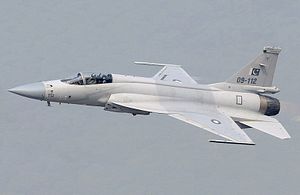The Pakistan Aeronautical Complex/Chengdu Aerospace Corporation (PAC/CAC) JF-17 “Thunder” Block III multirole fighter aircraft will have its first flight before the end of 2019, according to local media reports.
The aircraft is set to operationally deploy with the Pakistan Air Force (PAF) in 2020 and all 50 planned JF-17 Block IIIs are expected to be inducted by 2024, according to the PAF Chief of Air Staff, Air Chief Marshal Mujahid Anwar Khan.
The JF-17 Block III has already entered production at the Aircraft Manufacturing Factory (AMF) final assembly line at PAC Kamra.
“Production of subassemblies has already started for the first two 50 Block 3 aircraft, to be assembled next year, and will be followed by another 12 in 2021, 2022, 2023, and 2024,” PAC chairman Air Marshall Ahmer Shahzad was quoted as saying by AINonline. We will assemble eight dual-seaters this year, followed by 14 in 2020, and the remaining four in 2021.”
PAC has reportedly been producing 58 percent of the JF-17s airframe and subsystems — the wings, horizontal tail, vertical tail, and forward fuselage — while CAC produces 42 percent of it including the mid- and rear- fuselages. The aircraft parts arrive from China in kit form for local assembly. PAC has an annual production capability of about 25 JF-17 aircraft.
The PAF has currently 85 JF-17 Block I and II operationally deployed, although, according to recent reporting by Flight Global, the PAF has a total of 98 in-service JF-17s. That number is slated to expand to 112. The first PAF JF-17 squadron, consisting of 14 JF-17 Block I fighter aircraft, was established in 2010. The PAF currently has six operational squadrons.
The JF-17 was principally designed to replace the PAF’s aging fleet of Chengdu F-7 and Dassault Mirage III/5 fighter jets.
JF-17 Block I and II variants are powered by a Chinese license-built Klimov RD-93MA turbogan engine. Block III aircraft are expected to receive the RD-93MA or Chinese WS-13 engine. As I explained elsewhere:
F-17 Block III fighters will apparently receive a new electronic warfare system, upgraded avionics including a three-axis fly-by-wire digital flight control system, a helmet-mounted display and sight system, and Pakistan’s first Chinese-made active electronically scanned array (AESA) radar system. Two such radar systems are currently under evaluation, according to the PAF Air Chief: the Nanjing Research Institute of Electronics Technology’s KLJ-7A radar and the Leihua Electronic Technology Research Institute’s (LETRI) LKF601E.
According to reporting by Alan Warnes, Leonardo’s Grifo-E AESA radar system is also“still on the table.”
The PAF also plans to field a two-seat trainer variant of the JF-17 aircraft, dubbed JF-17B. Next to the 50 JF-17 Block III aircraft, the service is expected to procure up to 26 of the two-seat version of the fighter jet.
The JF-17 also made its second appearance at this year’s Paris Air Show.
































